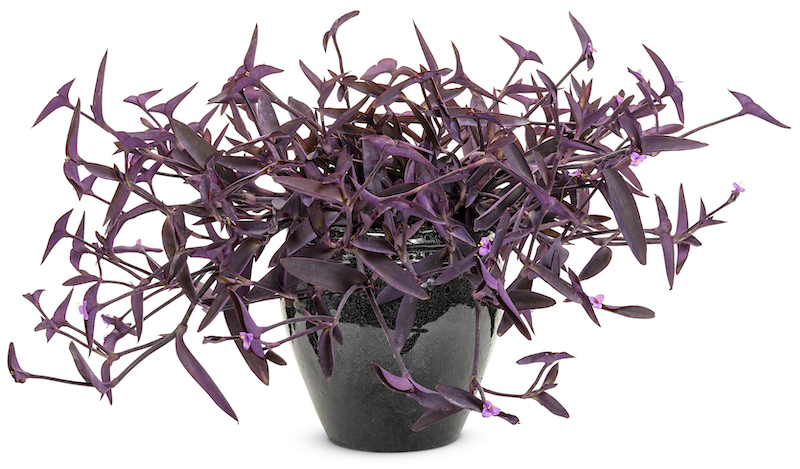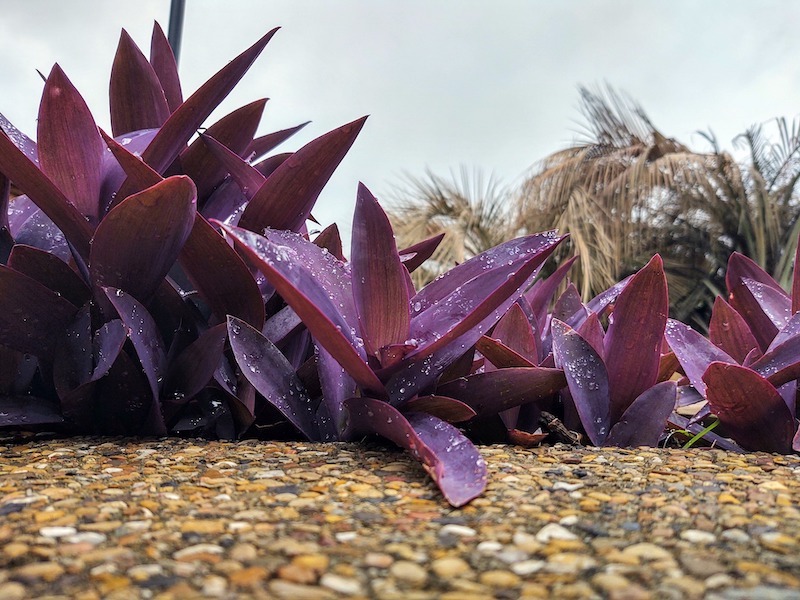Growing Tradescantia
Tradescantia is a diverse genus of plants native to North and Central America. Also known as inch plants or spiderwort, tradescantias are grown for their variable foliage, ranging from green to purple or magenta, with some varieties variegated with white, gray, or bubblegum pink. Many species of tradescantia even have fuzzy leaves that glisten in sunlight. One of the most common species is Tradescantia zebrina, although numerous species and cultivars exist. These fast-growing plants have small pink-purple or white flowers with three petals each. A perfect indoor plant for beginners, tradescantias grow just 6-12” tall, displaying a horizontal growth habit.

Tradescantia Sunlight Requirements
Bright indirect light is best for growing tradescantias. They may survive in lower light conditions, but may experience elongated, weak growth and leaf drop. Low light levels also cause fading of both leaf color and variegation. Similarly, direct light exposure may also lead to color loss. Plants grown in bright indirect light will have more vibrant foliage. Place your tradescantias near east, south, or west-facing windows.
Planting Tradescantia
Choose a sturdy, heavy pot that is more wide than it is deep for your tradescantias. These plants are shallow rooted, with most of their growth occurring above ground. Because of this, tradescantias may get top-heavy and are prone to tipping over if particularly vigorous. Pots should be 1-2” larger than the root ball with adequate drainage. Use a well-drained potting mix with added perlite. Tradescantias should be repotted once roots start poking out of the pot’s drainage holes. Repot in mid-spring once the growing season has started. This helps to reduce transplant shock and promote active growth. Wear gloves while potting and handling tradescantia, as some people experience irritation from its sap.

Watering Tradescantia
Tradescantia likes moist soil that dries out between waterings. Water thoroughly until water starts to pour out of the drainage holes. Overwatering is a major cause of tradescantia decline and death. Tradescantias will rot if their crowns are constantly wet. If preferred, bottom watering can be performed to prevent overwatering. To do this, fill a large container or sink with water. Insert the pot slowly, bottom-side down and allow water to enter through the drainage holes until the soil is evenly moist. Tradescantias are native to humid, tropical environments and appreciate high humidity. Dry air may lead to tip browning of leaves, especially in winter. Pebble trays with water or regular misting will provide humidity for tradescantia.
Fertilizing Tradescantia
Tradescantias should be regularly fertilized to encourage lush growth. Feed your tradescantias monthly throughout the growing season of spring through fall. Select a well-balanced fertilizer formulated for indoor use. A liquid fertilizer works well when used with irrigation. Dilute the fertilizer to half-strength, as too much fertilizer may affect leaf color and cause tip browning. Avoid fertilizing during winter.
Common Tradescantia Problems
Root rot is a common problem in tradescantia; check for brown, squishy roots and stems. Prune off any mushy tissue and repot into dry soil immediately. Sometimes, the leaves of purple or variegated tradescantia may turn green if exposed to low light levels. Cut off green leaves to prevent them from taking over, and increase the amount of light the plant receives. While tradescantia is not particularly susceptible to pests and diseases, it may pick up aphids, whiteflies, scale, or fungus gnats from neighboring houseplants. Treat with horticultural oil per label instructions. Diatomaceous earth or biocontrols may help as well, especially with fungus gnats. If your tradescantia is not blooming, lower the temperature to 60°F through winter into spring, being sure to expose the plant to ample light.
Propagating Tradescantia
Many tradescantias propagate themselves via layering, when stems come into contact with the soil. In this process, roots will develop on the stems in between the nodes, forming new plants. Another popular method of propagation is by taking stem cuttings. Using clean scissors or shears, take a cutting that is approximately 3” long. Remove the lower leaves and place in a glass of water. Change out the water often. Once roots grow to roughly an inch long, remove the cutting from the glass and place in well-drained soil. Stem cuttings can also be propagated directly in moist soil. While not required, rooting hormone may speed up the process. Tradescantias should be pinched back often to obtain a fuller habit, which leads to several opportunities to propagate the pinched stems.

Growing Tradescantia Outdoors
Most species of tradescantia can be grown outdoors as perennials in USDA zones 9-11, or as annuals in zones with colder winters. There are some perennial species, such as Tradescantia virginiana, that are native to cooler regions of North America (zones 4-9). Tradescantias grow best in light, dappled shade. They tolerate a wide range of temperatures and can be moved outside after the danger of frost has passed, and then moved back inside before the next frost in autumn. Tradescantia does well when planted in containers with other shade-loving annuals, where it can cascade along the sides of the pot. Acclimate all indoor tradescantia plants to outside light by keeping them in a fully shaded spot, out of direct sunlight, for a few hours a day, eventually increasing the amount of time outdoors until fully acclimated.
 |
Lauren Youngcourt - Published 03-02-2023 |
